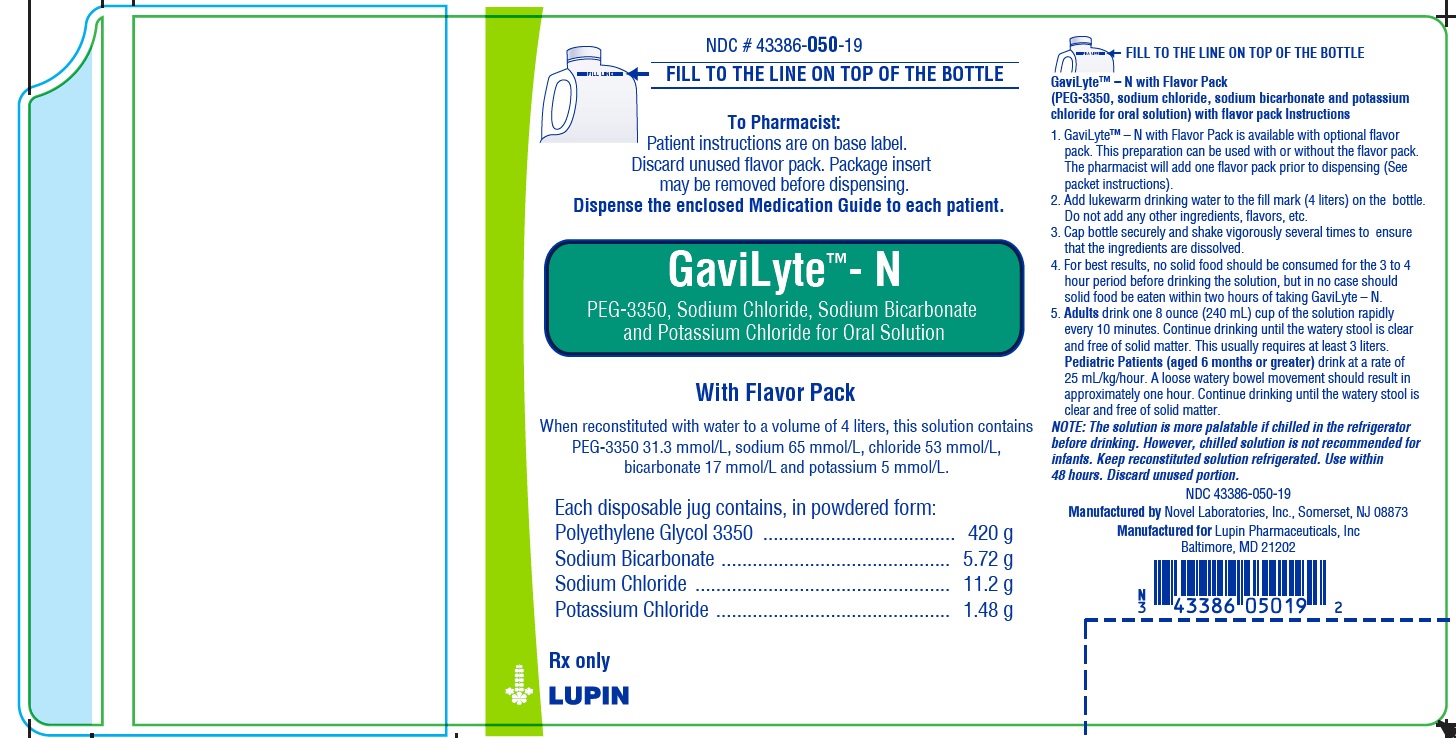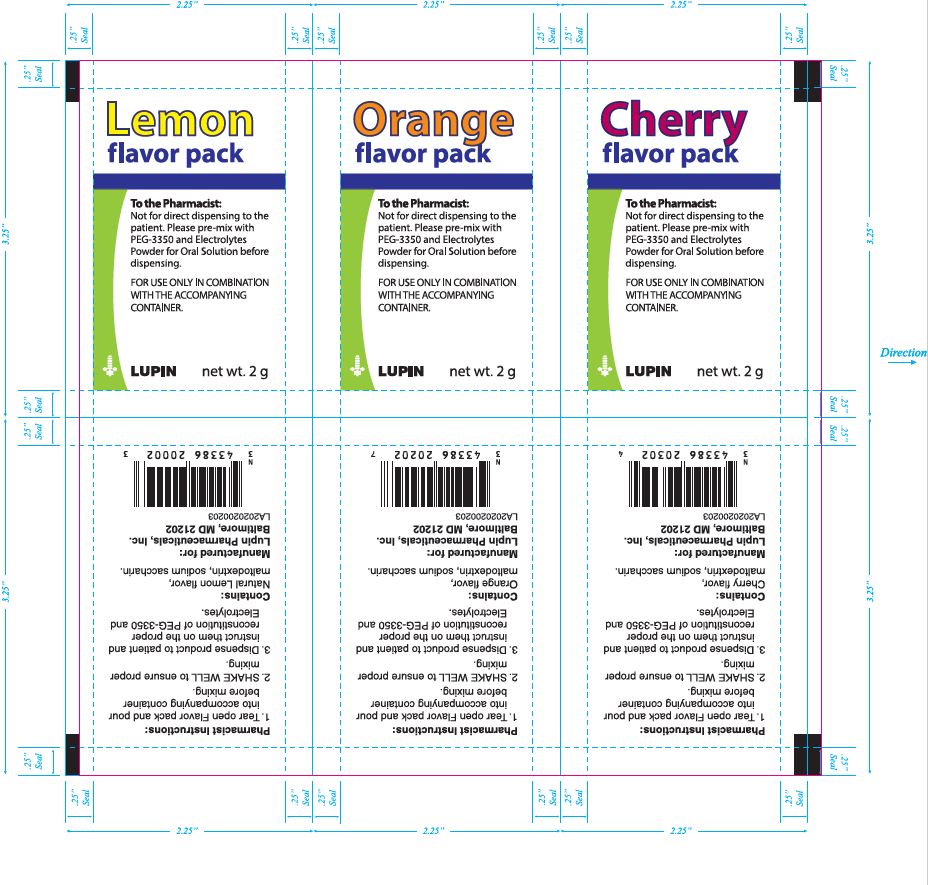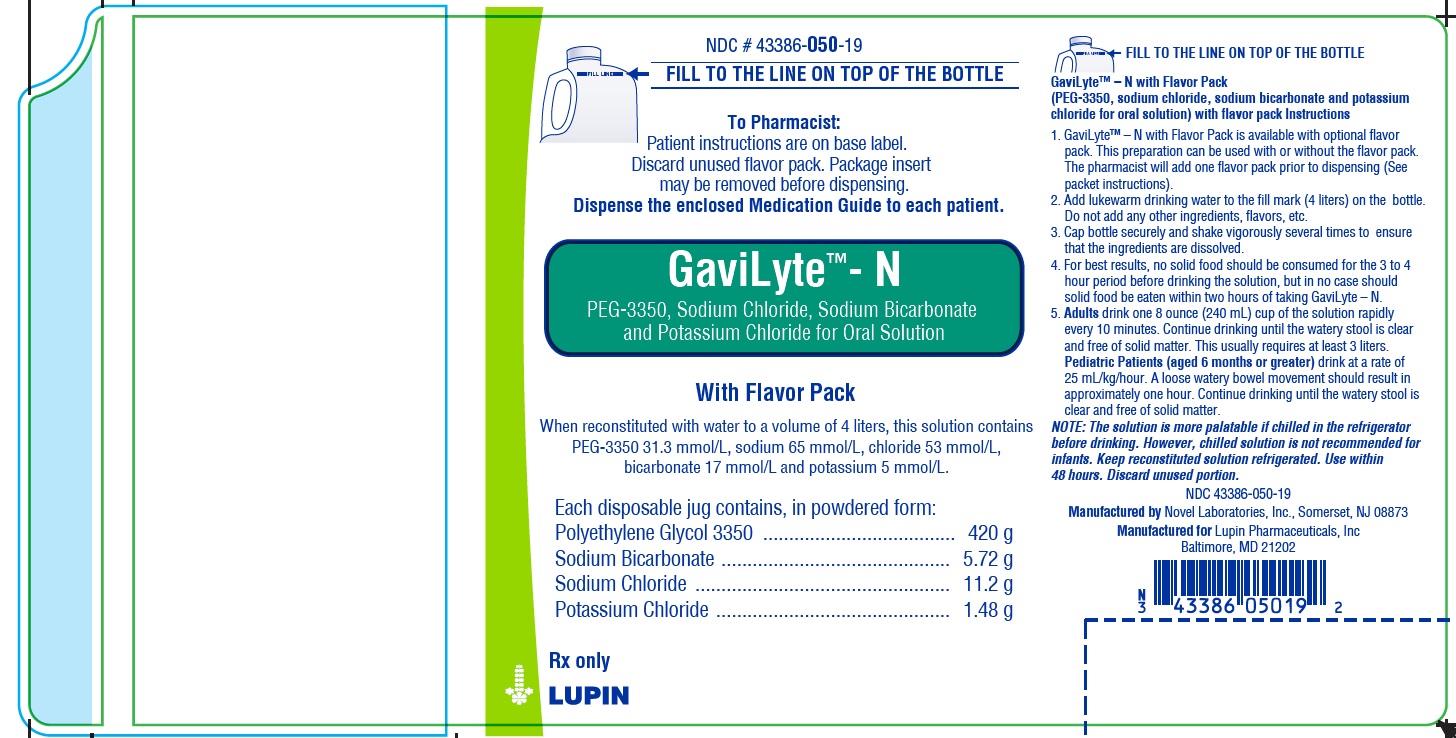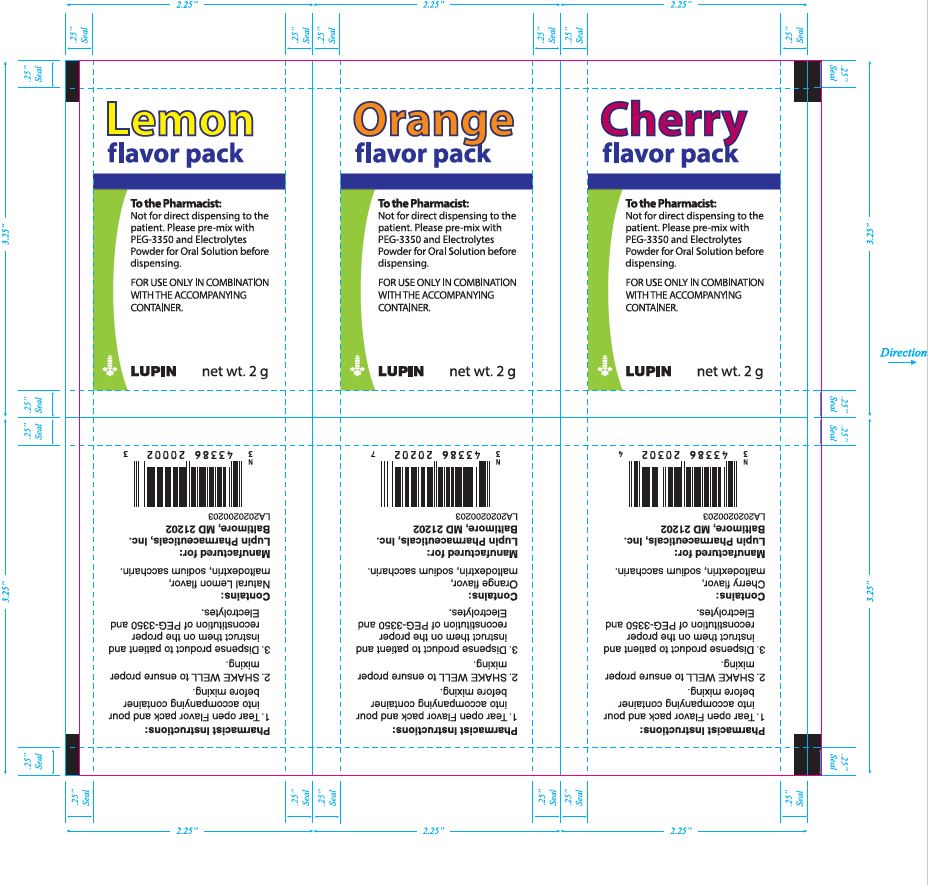Label: GAVILYTE-N- polyethylene glycol-3350, sodium chloride, potassium chloride and sodium bicarbonate powder, for solution
- NDC Code(s): 43386-050-19
- Packager: Lupin Pharmaceuticals,Inc.
- Category: HUMAN PRESCRIPTION DRUG LABEL
- DEA Schedule: None
- Marketing Status: Abbreviated New Drug Application
Drug Label Information
Updated January 9, 2024
If you are a consumer or patient please visit this version.
- Download DRUG LABEL INFO: PDF XML
- Medication Guide: HTML
- Official Label (Printer Friendly)
-
HIGHLIGHTS OF PRESCRIBING INFORMATION
These highlights do not include all the information needed to use GaviLyte – N safely and effectively. See full prescribing information for GaviLyte – N
GaviLyte™ – N (polyethylene glycol 3350 (420 g), sodium chloride, sodium bicarbonate and potassium chloride for oral solution)
Initial U.S. Approval: 1991RECENT MAJOR CHANGES
Warnings and Precautions, Aspiration: (5.7) 05/2021
INDICATIONS AND USAGE
GaviLyte-N is a combination of PEG 3350, an osmotic laxative, and electrolytes indicated for cleansing of the colon in preparation for colonoscopy in adults and pediatric patients aged 6 months or greater (1)
DOSAGE AND ADMINISTRATION
- GaviLyte-N, supplied as a powder, must be reconstituted with water before its use (2.1, 5.8)
- On day prior to colonoscopy, instruct patients to:
- Eat a light breakfast or have clear liquids (avoid red and purple liquids) (2.2).
- If adding a GaviLyte-N flavor pack, pour the contents of flavor powder (i.e., cherry, lemon or orange) into container prior to reconstitution (2.2).
- Early in the evening prior to colonoscopy, fill container containing GaviLyte-N powder with lukewarm water to 4 liter fill line (2.2).
- After capping container, shake vigorously several times (2.2).
- Instruct patients to consume water or clear liquids during and after bowel preparation up until 2 hours before time of colonoscopy (2.3).
- Adults: Drink at a rate of 240 mL (8 oz.) every 10 minutes, until 4 liters are consumed or rectal effluent is clear. For nasogastric tube (NGT), rate is 1.2 to 1.8 liters per hour (2.3)
- Pediatric patients (aged 6 months or greater ): Drink 25 mL/kg/hour orally or administer by NGT. Continue drinking until watery stool is clear and free of solid matter (2.3).
DOSAGE FORMS AND STRENGTHS
For oral solution: polyethylene glycol 3350 420 grams, sodium bicarbonate 5.72 grams, sodium chloride 11.2 grams, potassium chloride 1.48 grams, and flavoring ingredients 2 grams; supplied in one 4 liter disposable jug(3)
CONTRAINDICATIONS
WARNINGS AND PRECAUTIONS
- Risk of fluid and electrolyte abnormalities, arrhythmias, seizures and renal impairment– assess concurrent medications and consider testing in some patients (5.1, 5.2,5.3, 5.4)
- Patients with renal insufficiency– use caution, ensure adequate hydration and consider testing (5.4)
- Suspected GI obstruction or perforation – rule out the diagnosis before administration (4, 5.6)
- Patients at risk for aspiration – observe during administration (5.7)
- Not for direct ingestion – dilute and take with additional water (5.8)
ADVERSE REACTIONS
Most common adverse reactions (≥3%) are: nausea, abdominal fullness and bloating. Abdominal cramps, vomiting and anal irritation occur less frequently (6)
To report SUSPECTED ADVERSE REACTIONS, contact Lupin Pharmaceuticals, Inc. at 1-866-403-7592 or FDA at 1-800-FDA-1088 or www.fda.gov/medwatch.
DRUG INTERACTIONS
See 17 for PATIENT COUNSELING INFORMATION and Medication Guide.
Revised: 1/2024
-
Table of Contents
FULL PRESCRIBING INFORMATION: CONTENTS*
1 INDICATIONS AND USAGE
2 DOSAGE AND ADMINISTRATION
2.1 Dosage Overview
2.2 Administration Instructions Prior to Dosage
2.3 Dosage
3 DOSAGE FORMS AND STRENGTHS
4 CONTRAINDICATIONS
5 WARNINGS AND PRECAUTIONS
5.1 Serious Fluid and Serum Chemistry Abnormalities
5.2 Cardiac Arrhythmias
5.3 Seizures
5.4 Renal Impairment
5.5 Colonic Mucosal Ulcerations and Ischemic Colitis
5.6 Use in Patients with Significant Gastrointestinal Disease
5.7 Aspiration
5.8 Not for Direct Ingestion
6 ADVERSE REACTIONS
7 DRUG INTERACTIONS
7.1 Drugs that May Lead to Fluid and Electrolyte Abnormalities
7.2 Potential for Altered Drug Absorption
7.3 Stimulant Laxatives
8 USE IN SPECIFIC POPULATIONS
8.1 Pregnancy
8.3 Nursing Mothers
8.4 Pediatric Use
8.5 Geriatric Use
11 DESCRIPTION
12 CLINICAL PHARMACOLOGY
12.1 Mechanism of Action
12.2 Pharmacodynamics
12.3 Pharmacokinetics
13 NONCLINICAL TOXICOLOGY
13.1 Carcinogenesis, Mutagenesis, Impairment of Fertility
16 HOW SUPPLIED/STORAGE AND HANDLING
17 PATIENT COUNSELING INFORMATION
- *
- Sections or subsections omitted from the full prescribing information are not listed.
- 1 INDICATIONS AND USAGE
-
2 DOSAGE AND ADMINISTRATION
2.1 Dosage Overview
- GaviLyte-N, supplied as a powder, must be reconstituted with water before its use; it is not for direct ingestion [see Dosage and Administration (2.2), Warnings and Precautions (5.8)].
- Do not reconstitute with other liquids and/or add starch-based thickeners to the mixing container [see Warnings and Precautions (5.7)].
- The 4-liter reconstituted GaviLyte-N solution contains: 420 grams of polyethylene glycol (PEG) 3350, 5.72 grams of sodium bicarbonate, 11.2 grams of sodium chloride, and 1.4 grams of potassium chloride. GaviLyte-N may be used with or without one of the supplied flavor packs.
2.2 Administration Instructions Prior to Dosage
On the day prior to the colonoscopy, instruct patients to:
- Take only clear liquids, but avoid red and purple liquids. Patients may consume a light breakfast.
- If adding a GaviLyte-N flavor pack, pour the contents of the 2 gram flavor powder (i.e., cherry, lemon, or orange) into the container prior to reconstitution. No additional flavorings should be added. Discard unused flavor packs. The GaviLyte-N flavor packs are for use only in combination with the contents of the accompanying 4 liter container.
- Early in the evening prior to colonoscopy, fill the supplied container containing the GaviLyte-N powder (and if applicable, a flavor powder) with lukewarm water (to facilitate dissolution) to the 4 liter fill line. The solution is clear and colorless when reconstituted to a final volume of 4 liters.
- After capping the container, shake vigorously several times to ensure that the ingredients are dissolved. When reconstituted use within 48 hours.
2.3 Dosage
The following is the recommended dose of reconstituted GaviLyte-N solution for adults and pediatric patients ≥ 6 months. Instruct patients they may consume water or clear liquids during the bowel preparation and after completion of the bowel preparation up until 2 hours before the time of the colonoscopy. The solution is more palatable if chilled prior to administration.
- Adults: Instruct patients to drink a total of up to 4 liters at a rate of 240 mL (8 oz.) every 10 minutes, until 4 liters are consumed or the rectal effluent is clear. Rapid drinking of each portion is preferred to drinking small amounts continuously. For NGT, rate is 20 -30 mL per minute (1.2 – 1.8 liters per hour).
- Pediatric Patients ≥ 6 Months: Pediatric patients should drink 25 mL/kg/hour until the stool is watery, clear, and free of solid matter. If pediatric patients are unable to drink the reconstituted GaviLyte-N solution, the solution may be given by nasogastric (NGT). NGT administration is at the rate of 25 mL/kg/hour.
The first bowel movements should occur approximately one hour after the start of GaviLyte-N administration. Continue drinking until the watery stool is clear and free of solid matter.
-
3 DOSAGE FORMS AND STRENGTHS
For oral solution: One 4 liter jug with powder for reconstitution with water.
Each 4 liter jug contains: polyethylene glycol 3350 420 g, sodium bicarbonate 5.72 g, sodium chloride 11.2 g, potassium chloride 1.48 g and flavoring ingredients 2 g. When made up to 4 liters volume with water, the solution contains PEG-3350 31.3 mmol/L, sodium 65 mmol/L, chloride 53 mmol/L, bicarbonate 17 mmol/L and potassium 5 mmol/L.
-
4 CONTRAINDICATIONS
GaviLyte-N is contraindicated in the following conditions:
- Gastrointestinal (GI) obstruction, ileus, or gastric retention
- Bowel perforation
- Toxic colitis or toxic megacolon
- Known allergy or hypersensitivity to any component of GaviLyte-N for oral solution [see How Supplied/Storage and Handling (16)]
-
5 WARNINGS AND PRECAUTIONS
5.1 Serious Fluid and Serum Chemistry Abnormalities
Advise patients to hydrate adequately before, during, and after the use of GaviLyte-N. Use caution in patients with congestive heart failure when replacing fluids. If a patient develops significant vomiting or signs of dehydration including signs of orthostatic hypotension after taking GaviLyte-N, consider performing post-colonoscopy lab tests (electrolytes, creatinine, and BUN) and treat accordingly. Fluid and electrolyte disturbances can lead to serious adverse events including cardiac arrhythmias, seizures and renal impairment. Fluid and electrolyte abnormalities should be corrected before treatment with GaviLyte-N.
In addition, use caution when prescribing GaviLyte-N for patients who have conditions, or who are using medications, that increase the risk for fluid and electrolyte disturbances or may increase the risk of adverse events of seizure, arrhythmias, and renal impairment [see Drug Interactions (7.1)]
5.2 Cardiac Arrhythmias
There have been rare reports of serious arrhythmias associated with the use of ionic osmotic laxative products for bowel preparation. Use caution when prescribing GaviLyte-N for patients at increased risk of arrhythmias (e.g., patients with a history of prolonged QT, uncontrolled arrhythmias, recent myocardial infarction, unstable angina, congestive heart failure, or cardiomyopathy). Pre-dose and post-colonoscopy ECGs should be considered in patients at increased risk of serious cardiac arrhythmias.
5.3 Seizures
There have been reports of generalized tonic-clonic seizures and/or loss of consciousness associated with use of bowel preparation products in patients with no prior history of seizures. The seizure cases were associated with electrolyte abnormalities (e.g., hyponatremia, hypokalemia, hypocalcemia, and hypomagnesemia) and low serum osmolality. The neurologic abnormalities resolved with correction of fluid and electrolyte abnormalities.
Use caution when prescribing GaviLyte-N for patients with a history of seizures and in patients at increased risk of seizure, such as patients taking medications that lower the seizure threshold (e.g., tricyclic antidepressants), patients withdrawing from alcohol or benzodiazepines, or patients with known or suspected hyponatremia.
5.4 Renal Impairment
Use caution when prescribing GaviLyte-N for patients with impaired renal function or patients taking concomitant medications that may affect renal function (such as diuretics, angiotensin converting enzyme inhibitors, angiotensin receptor blockers, or non-steroidal anti-inflammatory drugs). Advise these patients of the importance of adequate hydration, and consider performing baseline and post-colonoscopy laboratory tests (electrolytes, creatinine, and BUN) in these patients.
5.5 Colonic Mucosal Ulcerations and Ischemic Colitis
Administration of osmotic laxative products may produce colonic mucosal aphthous ulcerations, and there have been reports of more serious cases of ischemic colitis requiring hospitalization. Concurrent use of stimulant laxatives and GaviLyte-N may increase this risk. The potential for mucosal ulcerations resulting from the bowel preparation should be considered when interpreting colonoscopy findings in patients with known or suspect inflammatory bowel disease (IBD).
5.6 Use in Patients with Significant Gastrointestinal Disease
If gastrointestinal obstruction or perforation is suspected, perform appropriate diagnostic studies to rule out these conditions before administering GaviLyte-N. If a patient experiences severe bloating, distention or abdominal pain, administration should be slowed or temporarily discontinued until the symptoms abate. If gastrointestinal obstruction or perforation is suspected, appropriate studies should be performed to rule out these conditions before administration of GaviLyte-N. Use with caution in patients with severe active ulcerative colitis.
5.7 Aspiration
Use with caution in patients with impaired gag reflex, unconscious, or semiconscious patients, and patients prone to regurgitation or aspiration. Such patients should be observed during administration of GaviLyte-N, especially if it is administered via nasogastric tube.
Do not combine GaviLyte- N with starch-based thickeners [see Dosage and Administration (2.1)]. Polyethylene glycol (PEG), a component of GaviLyte - N, when mixed with starch-thickened liquids reduces the viscosity of the starch-thickened liquid. When a PEG-based product used for another indication was mixed in starch-based pre-thickened liquids used in patients with dysphagia, thinning of the liquid occurred and cases of choking and potential aspiration were reported.
5.8 Not for Direct Ingestion
The contents of each jug must be diluted with water to a final volume of 4 liters (4 L) and ingestion of additional water is important to patient tolerance. Direct ingestion of the undissolved powder may increase the risk of nausea, vomiting, dehydration, and electrolyte disturbances.
-
6 ADVERSE REACTIONS
The following serious or otherwise important adverse reactions are described elsewhere in the labeling:
- Serious Fluid and Serum Chemistry Abnormalities [see Warnings and Precautions (5.1)] .
- Cardiac Arrhythmias [see Warnings and Precautions (5.2)] .
- Seizures [see Warnings and Precautions (5.3)] .
- Renal Impairment [see Warnings and Precautions (5.4)] .
- Colonic Mucosal Ulcerations, Ischemic Colitis and Ulcerative Colitis [see Warnings and Precautions (5.5)] .
- Patients with Significant Gastrointestinal Disease [see Warnings and Precautions (5.6)] .
- Aspiration [see Warnings and Precautions (5.7)] .
- Direct Ingestion [see Warnings and Precautions (5.8)] .
The following adverse reactions have been identified during post-approval use of GaviLyte-N. Because these reactions are reported voluntarily from a population of uncertain size, it is not always possible to reliably estimate their frequency or establish a causal relationship to drug exposure.
Nausea, abdominal fullness and bloating are the most common adverse reactions (occurred in up to 50% of patients) to administration of GaviLyte-N. Abdominal cramps, vomiting and anal irritation occur less frequently. These adverse reactions are transient and usually subside rapidly. Isolated cases of urticaria, rhinorrhea, dermatitis and (rarely) anaphylactic reaction have been reported which may represent allergic reactions.
Published literature contains isolated reports of serious adverse reactions following the administration of PEG-electrolyte solution products in patients over 60 years of age. These adverse events include upper GI bleeding from Mallory-Weiss Tear, esophageal perforation, asystole, sudden dyspnea with pulmonary edema, and "butterfly-like" infiltrates on chest X-ray after vomiting and aspirating PEG.
-
7 DRUG INTERACTIONS
7.1 Drugs that May Lead to Fluid and Electrolyte Abnormalities
Use caution when prescribing GaviLyte-N for patients who are using medications that increase the risk for fluid and electrolyte disturbances or may increase the risk of adverse events of seizure, arrhythmias, and prolonged QT in the setting of fluid and electrolyte abnormalities. Consider additional patient evaluations as appropriate [see Warnings and Precautions (5.1, 5.2, 5.3, and 5.4)] in patients taking these concomitant medications.
-
8 USE IN SPECIFIC POPULATIONS
8.1 Pregnancy
Animal reproduction studies have not been conducted with GaviLyte-N. It is also not known whether GaviLyte-N can cause fetal harm when administered to a pregnant woman or can affect reproductive capacity. GaviLyte-N should be given to a pregnant woman only if clearly needed.
8.3 Nursing Mothers
It is not known whether this drug is excreted in human milk. Because many drugs are excreted in human milk, caution should be exercised when GaviLyte-N is administered to a nursing woman.
8.4 Pediatric Use
Safety and effectiveness of GaviLyte-N in pediatric patients aged 6 months and older is supported by evidence from adequate and well-controlled clinical trials of GaviLyte-N in adults with additional safety and efficacy data from published studies of similar formulations. Use of GaviLyte-N in children younger than 2 years of age should be carefully monitored for occurrence of possible hypoglycemia, as this solution has no caloric substrate. Dehydration has been reported in one child and hypokalemia has been reported in 3 children.
8.5 Geriatric Use
Clinical studies of GaviLyte-N did not include sufficient numbers of subjects aged 65 and over to determine whether they respond differently from younger subjects. Other reported clinical experience has not identified differences in responses between the elderly and younger patients.
-
11 DESCRIPTION
For oral solution: Each 4 liter (4L) GaviLyte-N jug contains a white powder for reconstitution. GaviLyte-N is a combination of polyethylene glycol 3350, an osmotic laxative, and electrolytes (sodium chloride, sodium bicarbonate and potassium chloride) for oral solution.
Each 4 liter jug contains: polyethylene glycol 3350 420g, sodium bicarbonate 5.72 g, sodium chloride 11.2 g, potassium chloride 1.4 g. The solution is clear and colorless when reconstituted to a final volume of 4 liters with water.
Polyethylene Glycol 3350, NF
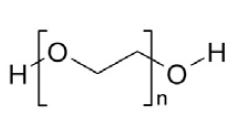
The chemical name is NaHCO3. The average Molecular Weight is 84.01. The structural formula is:
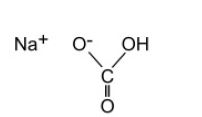
The chemical name is NaCl. The average Molecular Weight: 58.44. The structural formula is:
Na+ Cl-
Potassium Chloride, USP
The chemical name is KCl. The average Molecular Weight: 74.55. The structural formula is:
K-Cl
-
12 CLINICAL PHARMACOLOGY
12.1 Mechanism of Action
The primary mode of action is thought to be through the osmotic effect of polyethylene glycol 3350 which causes water to be retained in the colon and produces a watery stool.
- 13 NONCLINICAL TOXICOLOGY
-
16 HOW SUPPLIED/STORAGE AND HANDLING
In powdered form, for oral administration as a solution following reconstitution. GaviLyte-N is available in a disposable jug in powdered form containing:
GaviLyte-N with Flavor Packs: polyethylene glycol 3350 420 g, sodium bicarbonate 5.72 g, sodium chloride 11.2 g, potassium chloride 1.48 g and flavoring ingredients 2.0 g (optional). When made up to 4 liters volume with water, the solution contains PEG-3350 31.3 mmol/L, sodium 65 mmol/L, chloride 53 mmol/L, bicarbonate 17 mmol/L and potassium 5 mmol/L. Each jug has an attached package containing 3 flavor packs (optional); one each 2.0 g: Cherry, Lemon, and Orange flavoring, in powdered form, for the addition of ONE pack by the pharmacist prior to dispensing.
Lemon Flavor GaviLyte-N: polyethylene glycol 3350 420 g, sodium bicarbonate 5.72 g, sodium chloride 11.2 g, potassium chloride 1.48 g and flavoring ingredients 2.0 g. When made up to 4 liters volume with water, the solution contains PEG-3350 31.3 mmol/L, sodium 65 mmol/L, chloride 53 mmol/L, bicarbonate 17 mmol/L and potassium 5 mmol/L.
Storage:
Store at 25°C (77°F); excursions permitted to 15-30°C (59-86°F) [see USP Controlled Room Temperature]. When reconstituted, keep solution refrigerated. Use within 48 hours. Discard unused portion.
Keep out of reach of children.
GaviLyte-N with Flavor Packs NDC 43386-050-19
-
17 PATIENT COUNSELING INFORMATION
See FDA-Approved Patient Labeling (Medication Guide). Instruct patients:
- To let you know if they have trouble swallowing or are prone to regurgitation or aspiration.
- Not to take other laxatives while they are taking GaviLyte-N.
- To consume water or clear liquids during the bowel preparation and after completion of the bowel preparation up until 2 hours before the time of the colonoscopy.
- That if they experience severe bloating, distention or abdominal pain, the administration of the solution should be slowed or temporarily discontinued until the symptoms abate. Advise patients to report these events to their health care provider.
- That if they have hives, rashes, or any allergic reaction, they should discontinue the medication and contact their health care provider. Medication should be discontinued until they speak to their physician.
- To contact their healthcare provider if they develop signs and symptoms of dehydration [see Warnings and Precautions (5.1)].
- That oral medication administered within one hour of the start of administration of GaviLyte-N solution may be flushed from the GI tract and the medication may not be absorbed completely.
Novel Laboratories, Inc.
Somerset, NJ 08873
Manufactured for:
Lupin Pharmaceuticals, Inc.
Baltimore, MD 21202
SAP Code: 270544
Rev. 05/2022
-
MEDICATION GUIDE
(polyethylene glycol 3350 (420 g), sodium chloride, sodium bicarbonate and potassium chloride oral solution)
Read this Medication Guide before you start taking GaviLyte-N. This information does not take the place of talking with your healthcare provider about your medical condition or your treatment.
What is the most important information I should know about GaviLyte-N?
GaviLyte-N and other osmotic bowel preparations can cause serious side effects, including:
Serious loss of body fluid (dehydration) and changes in blood salts (electrolytes) in your blood.
These changes can cause:
- abnormal heartbeats that can cause death
- seizures . This can happen even if you have never had a seizure.
- kidney problems
Your chance of having fluid loss and changes in body salts with GaviLyte-N is higher if you:
- have heart problems
- have kidney problems
- take water pills or non-steroidal anti-inflammatory drugs (NSAIDS)
Tell your healthcare provider right away if you have any of these symptoms of a loss of too much body fluid (dehydration) while taking GaviLyte-N:
- vomiting that prevents you from keeping down the solution
- dizziness
- urinating less often than normal
- headache
See Section "What are the possible side effects of GaviLyte-N" for more information about side effects.
GaviLyte-N is a prescription medicine used by adults to clean the colon before a colonoscopy. GaviLyte-N cleans your colon by causing you to have diarrhea. Cleaning your colon helps your healthcare provider see the inside of your colon more clearly during your colonoscopy.
GaviLyte-N is safe and effective for use in pediatric patients aged 6 months and older.
Who should not take GaviLyte-N?
Do not take GaviLyte-N if your healthcare provider has told you that you have:
- a blockage in your bowel (obstruction)
- an opening in the wall of your stomach or intestine (bowel perforation)
- problems with food and fluid emptying from your stomach (gastric retention)
- a very dilated intestine (bowel)
- an allergy to any of the ingredients in GaviLyte-N. See the end of this leaflet for a complete list of ingredients in GaviLyte-N.
What should I tell my healthcare provider before taking GaviLyte-N?
Before you take GaviLyte-N, tell your healthcare provider if you:
- have heart problems
- have stomach or bowel problems
- have ulcerative colitis
- have problems with swallowing or gastric reflux
- have a history of seizures
- are withdrawing from drinking alcohol
- have a low blood salt (sodium) level
- have kidney problems
- any other medical conditions
- are pregnant. It is not known if GaviLyte-N will harm your unborn baby.
Talk to your doctor if you are pregnant or plan to become pregnant.
- are breastfeeding or plan to breastfeed. It is not known if GaviLyte-N passes into your breast milk. You and your healthcare provider should decide if you will take GaviLyte-N while breastfeeding.
Tell your healthcare provider about all the medicines you take, including prescription and non-prescription medicines, vitamins, and herbal supplements.
GaviLyte-N may affect how other medicines work. Medicines taken by mouth may not be absorbed properly when taken within 1 hour before the start of GaviLyte-N.
Especially tell your healthcare provider if you take:
- medicines for blood pressure or heart problems
- medicines for kidney problems
- medicines for seizures
- water pills (diuretics)
- non-steroidal anti-inflammatory medicines (NSAID) pain medicines
- laxatives
- starch-based thickeners. For patients who have trouble swallowing, do not mix GaviLyte-N with starch-based thickeners.
Ask your healthcare provider or pharmacist for a list of these medicines if you are not sure if you are taking any of the medicines listed above.
Know the medicines you take. Keep a list of them to show your healthcare provider and pharmacist when you get a new medicine.
You must read, understand, and follow these instructions to take GaviLyte-N the right way.
- Take GaviLyte-N exactly as your healthcare provider tells you to take it.
- Drink 240 mL (8 oz.) every 10 minutes. Rapid drinking of each portion is better than drinking small amounts.
- The first bowel movement should occur approximately one hour after you start drinking the solution.
- You may experience some abdominal bloating and distention before the bowels start to move. If severe discomfort or distention occur, stop drinking temporarily or drink each portion at longer intervals until the discomfort goes away.
- Continue drinking until the watery stool is clear and free of solid matter. This usually requires 3 liters and it is best to drink all of the solution.
- Do not take undissolved GaviLyte-N powder that has not been mixed with water (diluted), it may increase your risk of nausea, vomiting and fluid loss (dehydration).
- Each jug of GaviLyte-N must be reconstituted with water (diluted) to 4 liters total volume before drinking.
- Do not take other laxatives while taking GaviLyte-N.
-
Do not eat solid foods on the day before your colonoscopy and until after your colonoscopy . Drink only clear liquids:
- the day before your colonoscopy
- while taking GaviLyte-N
- after taking GaviLyte-N until 2 hours before your colonoscopy
What are the possible side effects of GaviLyte-N?
GaviLyte-N can cause serious side effects, including:
- See Section "What is the most important information I should know about GaviLyte-N?"
-
changes in certain blood tests . Your healthcare provider may do blood tests after you take GaviLyte-N to check your blood for changes. Tell your healthcare provider if you have any symptoms of too much fluid loss, including:
- vomiting
- nausea
- bloating
- dizziness
- stomach (abdominal) cramping
- headache
- urinate less than usual
- trouble drinking clear liquid
- heart problems. GaviLyte-N may cause irregular heartbeats.
- seizures
- ulcers of the bowel or bowel problems (ischemic colitis). Tell your healthcare provider right away if you have severe stomach-area (abdomen) pain or rectal bleeding.
The most common side effects of GaviLyte-N include:
- nausea
- stomach (abdominal) fullness
- bloating
- stomach (abdominal) cramps
- vomiting
- anal irritation
Tell your healthcare provider if you have any side effect that bothers you or that does not go away.
These are not all the possible side effects of GaviLyte-N. For more information, ask your healthcare provider or pharmacist.
Call your doctor for medical advice about side effects. You may report side effects to FDA at 1-800-FDA-1088.
How should I store GaviLyte-N?
- Store GaviLyte-N at room temperature, between 59ºF to 86°F (15ºC to 30°C).
Keep GaviLyte-N and all medicines out of the reach of children.
General information about the safe and effective use of GaviLyte-N.
Medicines are sometimes prescribed for purposes other than those listed in a Medication Guide. Do not use GaviLyte-N for a condition for which it was not prescribed. Do not give GaviLyte-N to other people, even if they are going to have the same procedure you are. It may harm them.
This Medication Guide summarizes important information about GaviLyte-N. If you would like more information, talk with your healthcare provider. You can ask your pharmacist or healthcare provider for information that is written for healthcare professionals.
For more information, call 1-866-403-7592.
What are the ingredients in GaviLyte-N?
Active ingredients: polyethylene glycol 3350, sodium bicarbonate, sodium chloride, and potassium chloride.
Inactive ingredients: cherry flavoring, lemon flavoring, orange flavoring (flavor packs only)
Manufactured by:
Novel Laboratories, Inc.
Somerset, NJ 08873
Manufactured for:
Lupin Pharmaceuticals, Inc.
Baltimore, MD 21202
This Medication Guide has been approved by the U.S. Food and Drug Administration.
SAP Code: 270544
Rev. 05/2022
- PACKAGE LABEL.PRINCIPAL DISPLAY PANEL
-
INGREDIENTS AND APPEARANCE
GAVILYTE-N
polyethylene glycol-3350, sodium chloride, potassium chloride and sodium bicarbonate powder, for solutionProduct Information Product Type HUMAN PRESCRIPTION DRUG Item Code (Source) NDC:43386-050 Route of Administration ORAL Active Ingredient/Active Moiety Ingredient Name Basis of Strength Strength POLYETHYLENE GLYCOL 3350 (UNII: G2M7P15E5P) (POLYETHYLENE GLYCOL 3350 - UNII:G2M7P15E5P) POLYETHYLENE GLYCOL 3350 420 g in 438.4 g SODIUM CHLORIDE (UNII: 451W47IQ8X) (CHLORIDE ION - UNII:Q32ZN48698) SODIUM CHLORIDE 11.2 g in 438.4 g SODIUM BICARBONATE (UNII: 8MDF5V39QO) (SODIUM CATION - UNII:LYR4M0NH37) SODIUM BICARBONATE 5.72 g in 438.4 g POTASSIUM CHLORIDE (UNII: 660YQ98I10) (POTASSIUM CATION - UNII:295O53K152) POTASSIUM CHLORIDE 1.48 g in 438.4 g Inactive Ingredients Ingredient Name Strength SACCHARIN SODIUM (UNII: SB8ZUX40TY) MALTODEXTRIN (UNII: 7CVR7L4A2D) Product Characteristics Color Score Shape Size Flavor LEMON, CHERRY, ORANGE Imprint Code Contains Packaging # Item Code Package Description Marketing Start Date Marketing End Date 1 NDC:43386-050-19 438.4 g in 1 BOTTLE; Type 0: Not a Combination Product 05/28/2009 Marketing Information Marketing Category Application Number or Monograph Citation Marketing Start Date Marketing End Date ANDA ANDA090019 05/28/2009 Labeler - Lupin Pharmaceuticals,Inc. (089153071) Registrant - Novel Laboratories, Inc. (793518643) Establishment Name Address ID/FEI Business Operations Novel Laboratories, Inc. 793518643 MANUFACTURE(43386-050) , ANALYSIS(43386-050) , PACK(43386-050)

